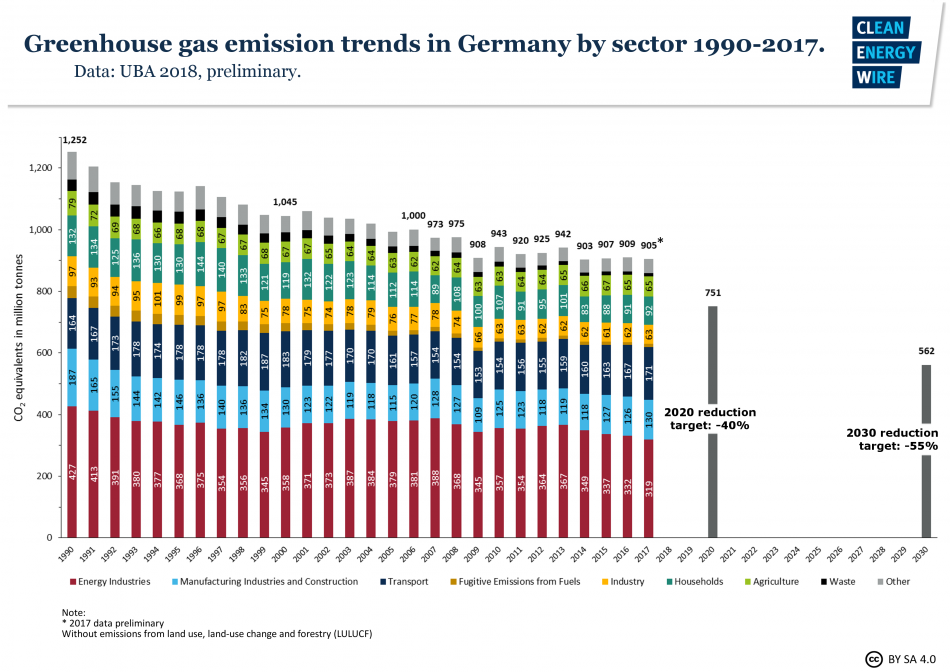German emissions dip a bit / NGOs want detailed coal exit path
Germany saw its greenhouse gas emissions dip slightly in 2017, as wind power continued to replace coal-fired electricity generation and hard coal power plants were shut down, new estimates released by the Federal Environment Agency (UBA) show. The data also revealed that the country has failed again to make any progress in the transport sector, where a growing passenger car fleet and increased road freight transport continue to produce harmful emissions. “In the transport sector, the developments unfortunately are still moving in the wrong direction,” said the new environment minister, Svenja Schulze, in a joint press release with UBA. “We need a fundamental transition in the transport sector toward climate protection and clean air. This must become a focus of this legislative period.”
Find the joint press release in German here.
Read the full story in the CLEW article Energy sector drives slight drop in German emissions in 2017.
dpa / Spiegel Online
Several German environmental organisations say they want to have a range of assurances from the German government before they participate in the so-called coal commission meant to prepare the end of coal-fired power production in the country, the news agency dpa reports in an article carried by Spiegel Online. NGOs BUND, NABU, WWF Germany, DUH, Germanwatch and others say a “balanced representation” of interest groups in the commission, “a clear exit path” for coal, and a 2025 climate target are necessary. They also call for an emergency programme aimed at meeting the country’s 2020 climate target, which should be decided on in parallel to the commission, the article says.
Find the article in German here.
For background, read the CLEW dossier The next German government and the energy transition.
Politico
Germany’s “enormously expensive Energiewende” green energy transformation is sputtering and the country is falling behind other European countries, writes Kalina Oroschakoff in an article for Politico.
Read the article in English here.
For background, read the CLEW dossier The energy transition and climate change and check out CLEW’s Easy Guide to Germany’s Energiewende.
dpa / Welt Online
Left and Green Party politicians in the German states of Saxony and Brandenburg want clarity about the follow-up costs of lignite mining in the eastern German region of Lusatia, reports the news agency dpa in an article carried by Welt Online. Left Party state parliament member Jana Pinka told radio broadcaster PSR that the conditions are expected to remain difficult in the future, and enough funds must be put aside in case energy companies go bankrupt. Otherwise, the taxpayers would have to foot the bill. Citing the case of old East German lignite mines, Pinka expects follow-up costs to reach several billion euros. Saxony’s economy ministry said that a concept is to be agreed by June 2018.
Read the article in German here.
See the CLEW factsheet Coal in Germany for more information.
German Energy Agency (dena)
Despite the significant changes in Germany’s energy system, the reliability of the power grid shows that there is a strong innovation dynamic in system services, writes the German Energy Agency (dena) in a report, citing redispatch measures as an example. A “hidden technological revolution” in the power grid, driven by the energy transition, is “a big opportunity for Germany as a research and development location,” said dena head Andreas Kuhlmann in a press release. According to the agency, numerous research and pilot projects continue to employ new technologies and processes.
Read the press release in German here, and find the full report in German here.
For background, read the CLEW factsheet Re-dispatch costs in the German power grid.
Süddeutsche Zeitung
Only about 20 percent of organic household waste in Germany is used to produce biogas for heating and power generation, writes Ralph Diermann in an article for the Süddeutsche Zeitung. Investment needs and operating costs for the required facilities are too high, and disposal companies struggle with non-organic waste mixed in with organic waste. Also, many Germans put their organic waste in the residual waste, which goes to incineration plants, writes Diermann. He adds that due to regulatory conditions, waste biogas facilities have a hard time competing with agricultural biogas plants in the auctions for renewables support.
Read the article in German here.
For background, read the CLEW dossier Bioenergy in Germany and the factsheet Bioenergy in Germany – facts and figures on development, support and investment.


